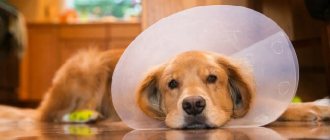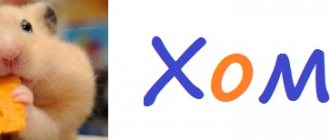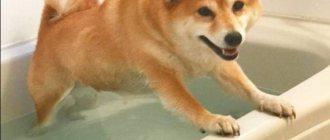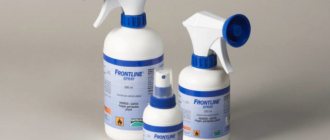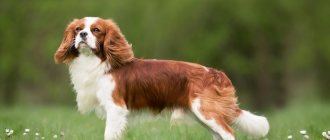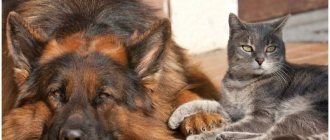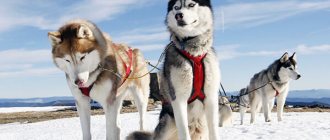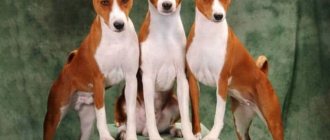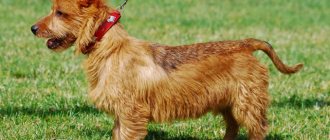| Type |
|
| Size | large (26-50kg) |
| Main features |
|
| Included in |
|
| Frequent illnesses |
|
| Intelligence | 85% |
Akita. Video
Akita Inu is a dog with an original appearance and amazing character. She became a symbol of loyalty and devotion. The Japanese breed was glorified by a real dog named Hachiko, who waited for his owner at the station for 9 years. A monument was erected to him in his homeland, and a film was made about him in Hollywood. This is how the story of the faithful Akita Inu became known all over the world.
In addition, the breed has gained recognition as a responsive companion and an excellent nanny. As a result, she gained extreme popularity. However, those who got this dog encountered unexpected problems: it turned out that not everyone could understand its complex and independent character in Japanese.
You will find even more useful information about the charming but difficult Akita Inu, its upbringing and maintenance below.
History of the Akita Inu breed
Akita Inu is an original Japanese breed. The ancestors of these dogs lived with people since the 16th century. They were slightly smaller than modern dogs, but successfully helped their owners hunt large game: deer, wild boars and even bears. By the way, the breed got its name from its place of origin. Akita is an area in the north of the island of Honshu. And “inu” in Japanese means dog.
Later, when Akitas became larger, they began to be used to guard homes. The cute-looking, but strong and serious dogs also coped with this task perfectly. As a result, their merits, beauty and courage were noted at the imperial court. In the 17th century, the Aktita Inu breed received a special status. The dogs were recognized as elite, and their own servants were assigned to them. They were forbidden to shout at them, much less raise their hand. At one time, there was even a decree of the emperor, according to which the murder of Aktita Inu was punished by death.
In Japan, it is still customary to give Akita Inu dogs as a sign of special favor. This honor is given to citizens of foreign countries who have done something useful for the Land of the Rising Sun. In 2012, the governor of the Japanese Akita prefecture presented a representative of the legendary breed to the President of Russia. This is how they thanked him for his help in eliminating the consequences of the tsunami and earthquake. The fluffy “present” was named Yume, which means dream in Japanese.
In the imperial palace, handsome red-haired men did not prosper for very long. At the end of the 19th century, dog fighting became popular among the common population of Japan. Tall, strong and fearless, Akita Inu have proven themselves to be excellent fighters.
At the beginning of the 20th century, these beautiful dogs were almost exterminated; they died at the whim of people in fierce battles. In 1908, dog fighting was banned, but only a few representatives of the breed remained. Then the Japanese government became concerned about preserving the national breed. In 1931, Akita Inu was recognized as a natural monument that needs protection. But during the Second World War, the population declined sharply again. It’s all because of thick, warm fur; they started making clothes for the army from it. In addition, the purity of the breed was at risk. Japanese dogs began to be bred with German shepherds.
In the second half of the 20th century, breeders made a lot of efforts to return the Akita Inu to its original appearance and former character. But her purpose changed, she stopped doing the work of a hunter and watchman. The latest breed standard was adopted by the Fédération Cynologique Internationale (FCI) in 2001. It says that this is a companion dog, related to the Asian Spitz.
Devotion until death that touches the heart
Wikipedia has many articles that can share interesting stories with readers. For example, the biography of a professor from Japan Hidesaburo Ueno. It is this person who plays the main role in the story about the dog. A Japanese professor of agriculture at the University of Tokyo is Hachiko's real master. But first things first.
The puppy was born back in 1923 in the town of Akita. The farmer presented the puppy to Hidesaburo Ueno, who already had seven dogs. The professor decided to name the new four-legged pet hatiko, which means “eighth” in Japanese. Hachiko fell in love with his new owner very quickly. The faithful four-legged friend literally followed Ueno everywhere, fulfilled all requests, and demanded communication with a person.
Real photo of Hachi at the station
Every day, the dog Hachiko accompanied his master to Shibuya Station, from where the professor went to the University. At the end of the working day at 6 pm, the animal returned to the station to meet Hidesaburo Ueno and go home with him. Wiki tells that every day the four-legged pet waited for its owner in the same place. He patiently waited for the moment when he and his loved one could go home.
The story about Hachiko does not end there. Unfortunately, this friendship did not last for many years. On May 21, 1925, the dog could not wait for his owner. On this day, a tragedy happened to the professor: while working, Hidesaburo Ueno had a heart attack. He was taken to the clinic, but doctors were unable to save him - death occurred within the hospital walls.
As usual, at six o'clock in the evening, one and a half year old Hachiko went to the station to meet his friend. But time passed, and Hidesaburo Ueno did not appear. The animal returned to Shibuya Station every day for the rest of its life. Hachiko waited for his owner at the Japanese train station for 9 years. He returned again and again, peered at passers-by and looked for his man.
Appearance of Akita Inu dogs
The Akita Inu has the same appearance as the native Japanese breeds, but is larger than the Ainu and Shiba. The dog looks noble and proud, it is tall and strong. Males are a maximum of 70 cm at the withers, females are much smaller - 64 cm, and they are more graceful. Great importance is attached to correct proportions; the figure of the animal must fit into an almost square format (10:11).
The Akita Inu has a large head with a wide forehead, which is divided by a vertical hollow. But there are no wrinkles or folds like those of a chow chow. The transition to the muzzle is clearly visible. The nose is straight with a large black nose; partial absence of pigmentation is allowed only in white dogs. The eyes are dark brown, not very large, slightly slanted, with a standard cut in the shape of an elongated triangle. The small ears, slightly rounded at the end, stand up and bend slightly forward. They give the impression that the dog is alert and listening carefully.
The Japanese Akita has a special muzzle structure; even in a calm state, the corners of its lips are slightly raised. That is why it is most often called the smiling dog.
The neck of the Akita Inu is powerful, muscular, but proportional. The back is strong and level, ending in a fairly wide loin. The chest is well developed. The belly is lean. The tail for dogs of this breed is a special decoration. It should be thick, twisted into an ellipse, circle or semi-ring, and thrown over the back. By the position of the tail you can assess the well-being of the Akita. He will always be on his back if the dog is alert, healthy and confident. By the way, lovers of the breed claim that each tail is a unique creation of nature.
The limbs of Akita Inu dogs are tall, smooth and muscular. The paws are thick and tightly knit. The dog moves springily, powerfully and sweepingly. He is perfectly coordinated.
The Akita Inu has a medium-length coat, harsh on top, with a soft and dense undercoat underneath. This makes the dog look like a plush dog. On the withers, lower back and tail the hair is slightly longer than on the body.
The standard approves three types of color: red, pure white, and the least common is brindle.
Red and brindle dogs must have such a color feature as urajiro. This is hair bleached to a whitish hue on the sides of the head, on the cheekbones, lower jaw, along the bottom of the chest, body, tail, and also on the inside of the limbs.
All deviations from the breed standard are considered faults. The most serious: inconsistency with the gender type, bite problems, lack of a full set of teeth, spotted tongue, light eyes, short tail.
Dogs with the following defects are subject to disqualification:
- drooping ears
- Dark mask
- Shaggy coat (excessively long)
- Spotting in white dogs
- Tail not carried over the back.
Breed standard
The Great Japanese Dog is a large animal with impressive weight and heavy bones. The muscles are well developed in all parts of the body. The height of adult individuals is 61-71 cm , weight is about 45-65 kg .
A large head rests on a powerful, short neck. Against its background, triangular, erect ears seem small. The eyes are dark, not large. The muzzle is wide, the nose is black. Square jaws. The canines are large, the bite is scissor-shaped, but straight is also not considered a defect.
The back is straight, the chest is wide. The stomach is tucked. Legs are straight with well-developed muscles. The toes are webbed.
The fluffy tail is beautifully wrapped in a ring. The double coat reliably protects the Akita from the cold; it is hard to the touch. There is an extremely dense, dense undercoat. Unlike cover wool, it is soft, as if airy.
Thanks to it, the dog can stay outside even at very low temperatures (20-30 degrees below zero). The hair on the tail is the longest, which serves as a decoration for the dog. The coat color of the American Akita is quite varied. Most often, representatives of the breed are gray or red.
Any color should have white spots on the limbs, tail and chest.
Character and characteristics of the Japanese Akita
According to the standard, Akita Inus should have a reserved, obedient, but not timid character. Of course, one of the main traits of dogs of this breed is loyalty.
The dog looks very cute, like a plush toy. However, you should not expect particularly cutesy behavior from a pet with Japanese roots. Akita Inu, like its two-legged compatriots, is full of dignity in any situation. She shows her emotions with extreme restraint. People who have previously owned people-oriented Labradors or Shepherds may find this behavior unnecessarily cold. For example, an Akita Inu will not jump up and down like a puppy with happiness and come with obsessive caresses when the owner comes, although he will be glad to see him. She will just calmly say hello and go about her business.
The Akita Inu dog is a pronounced introvert. She is always in herself and often by herself, as if she is constantly thinking about something and analyzing something. It is for this reason that people who have previously interacted with working dogs or temperamental terriers believe that the Akita Inu is disobedient and does not learn commands well. In fact, she understands everything perfectly well, but before she does it, she thinks: is it necessary to do it.
Akita Inu is smart and believes that it can make its own decisions. This breed is absolutely not suitable for those who want to command a dog and subjugate it. But the Akita will make an excellent companion or partner for games, long walks and quiet time. But first, the owner must gain the authority and respect of the pet. This dog is absolutely not suitable for nervous, angry and unrestrained people.
The Akita Inu dog can also be a vigilant and reliable guard; it protects not only its home, but also the pack, this is the whole family, including children and other pets. The Akita does not greet strangers vigorously, but does not show aggression either. She watches warily, as if she is looking closely at what kind of person has come into the house and whether he needs to be kept under control.
Akita Inu can also become a caring nanny. She is ready to entertain and amuse the child. And if he is too annoying, most likely the dog will simply leave. However, unintelligent children should not be left with a four-legged assistant for a long time. They must clearly understand that this is not a toy, but a living creature that may also run out of patience.
The Akita Inu will get along well with other pets, especially if they have already been in the house. But you need to be careful when getting new pets. On the street, the Japanese Akita can show aggression towards other dogs of the same sex. This behavior must be stopped from puppyhood. The sooner a young dog begins to socialize, for example, begins to socialize at the dog park, the calmer he will be when meeting strangers.
The Japanese say that the main distinguishing quality of the Akita Inu is “innate valor.” These two words include many concepts: a calm and balanced character, a stern but gentle disposition, as well as courage and independence.
Fans of this breed compare it to Japanese bonsai trees. Living sculptures take a long time and painstakingly to grow. You need to do the same with an Akita Inu, you will have to show a lot of patience and find enough time to understand her character and explain to her what you want. Many fans of Japanese dogs believe that their pets understand human language. But for this you need to try and establish contact. But as a result, you will raise the most faithful and understanding friend, like the famous Hachiko. By the way, adult dogs and even older Akita Inu puppies endure a change of owner with great difficulty. They get bored and may lose their appetite.
Pros and cons of the Akita Inu breed
Like every breed, Akita Inu dogs have their own advantages and disadvantages. But some qualities are difficult to categorize. For example, amazing devotion is, on the one hand, a plus. But it is precisely because of this that it is difficult for actita inu to get used to a new owner - this is already a minus.
Let us still try to determine the main positive characteristics of the breed:
- Innate intelligence
- Courage
- Developed protective instinct
- Ability to get along with children
- Restraint and calm
- Silence
- Cleanliness.
And now a few reasons against getting an Akita Inu:
- Extremely independent character
- Desire to dominate
- Needs long walks, preferably off leash
- Selectivity in nutrition.
Education and training
Dog handlers do not advise inexperienced dog breeders to own an Actita Inu. The future owner must be prepared to raise a rather wayward pet. The owner of a shepherd (or other service dog) may also encounter difficulties with communication and training. The Akita Inu has a completely different mentality. She cannot be trained in the full sense of the word. But she needs to be consistently and constantly educated, from a very young age and throughout her life. After all, a dog is an eternal child.
Akita Inu babies are terribly cute creatures. You want to cuddle them, let them play around and play around. In addition, from puppyhood they know how to use their cuteness. They can make touching eyes, get offended and refuse to eat if they are punished. But you cannot fall for these tricks. You need to set the rules once and for all and stick to them. Moreover, the whole family must follow the established order, otherwise the puppy will not understand what is required of him.
The dog is growing very quickly. If you show weakness and inconsistency in upbringing, by a year and a half a naughty dog may grow up who will ignore prohibitions. He will run away while walking, become aggressive, and do other unacceptable things.
A particularly difficult age is adolescence, from about 10 months to one and a half years. Then the dog will try to move up the hierarchical ladder in the family; he can run away, be willful and test the patience of his owners. Well, at this time you will have to be patient and act firmly. Akita Inu must understand who the real leader of the pack is and know his place.
Akita Inu needs a patient and persistent teacher. Shouting and punishing you will not achieve a positive effect from her. But with persistent repetition and affection you can achieve a lot. In addition, Akitas are very willing to learn if they are rewarded with treats. As the breeders of this breed assure, their pets easily master even complex tricks. They can be trained in rescue skills and made hunting assistants. They also love cycling and jogging together.
As experienced dog breeders say, you need to learn to negotiate well with an Akita. The dog categorically does not accept physical influence; it may lose respect for its owner and become embittered. And strict intonation is an effective remedy.
The most important thing is to pay attention not only to the puppy, but also to the adult dog. Of course, the Akita Inu is an independent and self-sufficient dog, but it also requires affection and communication with a person. An uninteresting dog that is left alone all day will begin to look for adventures and entertainment on its own. Then furniture and other things will be in trouble.
Care and maintenance of an Akita Inu dog
Akita Inu is an easy-to-maintain dog. Thanks to its thick undercoat, it can live in an enclosure or just in the yard. However, the fence on the site must be high, from 2 meters. The dog jumps well and can leave the territory without permission. For a comfortable life, you need to equip an insulated house. In hot weather, ensure constant access to water. Just don’t try to make a chain watchman out of a Japanese dog. This breed loves freedom too much.
The Aktita Inu will also fit in well in an apartment. But the owner must take into account that the pet will need quite long and active walks, at least an hour every day. The dog needs to run and jump to release excess energy. Otherwise, she will become a mischief at home. There is another problem: many owners are unhappy that the Akita has to be let off the leash in order for it to relieve itself. And then it's hard to get her to come over.
Akita Inu is a silent dog. She will not bark for no reason, and if the situation requires a reaction, she will growl, snort or even grunt.
The future owner needs to provide the puppy with a living wage. It is worth purchasing two bowls in advance (for water and food), preferably on stands, as well as several toys (they will have to be renewed as they are chewed). In addition, you will need a collar (or harness) and leashes of different lengths, a bed and soft bedding. This dog doesn't really need warm clothes. But a light overall, if worn in the rain, will protect the wool from dirt.
Hygiene and grooming
The main hygienic procedure in caring for an Akita Inu is combing. This should be done at least twice a week. During a coat change, preferably every day. Otherwise, fluffy lumps will roll around the corners. But you practically won’t have to bathe dogs of this breed. They are clean by nature and rarely get into the mud.
From the first days, the puppy must be taught to examine and clean its ears and teeth. The dog should calmly accept these manipulations. Sometimes it is worth checking the length of the claws and shortening them if necessary. Although usually in active dogs they wear off on their own.
The dog must be regularly treated for internal and external parasites, and also vaccinated. The veterinarian will recommend which vaccinations are needed.
Nutrition
Many Akita Inu owners complain that their dogs are quite picky when it comes to food. In addition, allergy sufferers are often found among them. When picking up a puppy from a breeder, you should definitely consult how he was fed. And for the first two to three months, stick to the same diet. Then you can change the power type.
Ready-made food is convenient to give; dry mixtures contain a full range of proteins, carbohydrates and fats, as well as vitamin supplements. But you need to carefully choose what suits your pet.
The following foods can cause allergies in Akita Inu: chicken and other poultry meat, veal, fatty dairy products, corn, oatmeal. Give this food with caution.
Properly organizing natural nutrition is much more difficult. The traditional diet of Japanese dogs consisted of fish (dried and fresh), rice, seaweed and vegetables. However, modern Akita Inu are already accustomed to meat and offal. They can be given fruits, berries and fresh vegetables as a vitamin supplement. It is worth enriching your food with dried seaweed (they are sold in pharmacies), they are a source of iodine.
pros
- Cleanliness . They are easy to care for and do not have a specific smell. It is not recommended to bathe the animal too often; this should be done 1-2 times a year. You need to brush the fur a couple of times a week to prevent it from spreading throughout the house.
- High level of intellectual development , which affects the animal’s learning ability. If you say something to an animal, it can understand the owner perfectly and perform the given action.
- The animal loves to walk , and if the owner leads an active lifestyle, then this advantage will allow him to better communicate with his dog. While walking, it will be easy to teach your dog the “fetch” command.
- Good protective qualities. A dog, like a watchman, protects the owner’s property, without fear of dangers and difficulties. It is best to get cables for these purposes, since they have the most developed protective instincts.
- The presence of a hard coat with a thick undercoat allows it to easily endure any weather conditions. That is, Akita Inu can live both in an outdoor enclosure and in a house.
- Uncompromisingness , which allows you to raise a good watchdog from an Akita Inu representative.
- Unobtrusiveness and independence.
- Loyalty to his master.
- He is wary of strangers.
- Doesn't bark over trifles.
- Has a calm temperament.
Health and illness
The Akita Inu breed is classified as primitive. In other words, breeders practically did not deal with it, but only nature itself. Therefore, Japanese dogs have strong immunity and good health. With proper care, sufficient physical activity and a balanced diet, they rarely get sick.
Akita Inu, like most large dogs, has joint dysplasia, hip or elbow. Another problem is thyroid dysfunction, which is also associated with skin diseases. Congenital visual defects occur. The most typical for this breed is an inversion or inversion of the eyelid. These diseases are inherited. Therefore, good breeders monitor the health of parent couples and do not allow problem dogs to breed.
In addition, Akita Inus may suffer from bloating caused by gas. To prevent this, it is necessary to exclude provoking foods from the diet, feed the dog in small portions, and do not give physical activity immediately after eating. If the problem does not resolve, it can cause volvulus. Then you need to urgently contact a veterinary clinic.
Origin story
There are 14 of the oldest dog breeds, which is confirmed by genetic research. The Akita Inu is one of these very ancient breeds, which is confirmed by many images of a dog similar to a similar breed that have survived to this day. The ancestors of these dogs lived more than 2 thousand years ago in the northern regions of the island of Honshu, and only in the 17th century was the familiar appearance of this breed formed. According to experts, the breed was formed as a result of crossing a mastiff with a Chinese Spitz dog or crossing a mastiff with Siberian huskies.
In the early stages of development, this breed was in demand among peasants and hunters, but over time the nobility also became interested in it. Already in the 18th century, this breed began to be considered elite, since it was kept by the ruling aristocracy, as well as the imperial family. The care given to these dogs was exceptional and represented a certain type of palace ceremony. The emperor signed a law that prohibited harming or taking the life of this dog under pain of severe punishment.
Interesting to know! If we translate the name Akita Inu from Japanese, then there is nothing complicated in this name. The word "inu" means "dog", and "akita" corresponds to the name of the prefecture of the island of Honshu. Therefore, it is not difficult to guess where exactly this dog breed originated.
In 1927, the Akita Inu Preservation Society was created, which began preserving the purity of this breed. During the war, these dogs showed everything they were capable of at the front, while there were not many purebred individuals left, but thanks to them, it was possible to restore the Akita Inu breed.
The Kara Futo and Tosa Inu breeds appeared as a result of crossing the Akita Inu breed with other, more aggressive breeds, therefore, recently Akita Inu have become more massive, and their behavior has become more temperamental.
How to choose an Akita Inu puppy
As you have seen, the Akita Inu breed is quite complex. This dog is not for everyone. It can be handled well by a self-confident person who will be patient and persistent in raising a pet. Therefore, the future owner needs to evaluate not so much the appearance and character of the Akita, but his qualities and capabilities. Is he ready to work hard with the puppy, not to succumb to its tricks, in order to ultimately raise the endlessly loyal Hachiko?
If you are confident in your abilities and still dream of owning an Akita Inu, take your time and study the breed in more detail. Take a look at how people and dogs communicate. Go to shows, talk to owners and make contacts with breeders.
Akita Inu is not a very popular dog in Russia, but not super rare either. Therefore, it is better to purchase a puppy from a reputable nursery. This way you will get a guarantee that you are buying a pet that not only looks like an Akita, but also has certain character traits and a normal psyche. This is very important for a large breed dog.
A purebred Akita Inu puppy must have a puppy card, which is then exchanged for a pedigree. After 6-8 weeks of life, the puppy is given a veterinary passport, where vaccinations are stamped. A conscientious breeder will definitely give recommendations on feeding and keeping the dog.
When choosing a puppy, you should first of all get to know its parents and their documents. You should ask whether the couple was tested for hereditary diseases. If everything is in order, start getting acquainted with your future pet. Observe the puppies in their natural environment. Choose the most active and curious one. As a rule, such cubs are in good health.
How much do Akita puppies cost?
Akita Inu puppies are offered at different prices, it can vary by 5 or more times. The cost depends on the achievements of the nursery and the qualities of the parent pair. Cubs with good conformation from champions will cost the most. They can be purchased for an average of 80 thousand rubles. Then such a dog will be able to take part in exhibitions and be used for breeding.
From the same breeders you can find purebred Akita Inu at a lower price. If a puppy has any inconsistencies with the breed, it is classified as a pet (pet class) and sold much cheaper, for about 20-30 thousand rubles. These dogs cannot be exhibited and offspring cannot be obtained from them.
And Akita Inu puppies without any documents are offered on the Internet for a very modest price - from 5 thousand rubles. But no one guarantees that you will buy an adequate dog, and not a mixture of unknown breeds.
Rating of the 10 best dry food for American Akita
| Place | Name | Rating | Price, rub. |
| 1 | Belcando Junior Maxi for large and giant breed puppies from 3 to 18 months (15 kg) | 10 / 10 | 5 214 |
| 2 | Acana Puppy Large Breed, 11.4 kg | 10 / 10 | 5 050 |
| 3 | Royal Canin Maxi Adult, 15 kg | 9 / 10 | 4785 |
| 4 | Almo Nature Holistic beef 12 kg | 9 / 10 | 4279 |
| 5 | Purina Pro Plan Optiderma for healthy skin and coat, salmon with rice, 14 kg | 8 / 10 | 4113 |
| 6 | Brit Care lamb with rice 12 kg | 9 / 10 | 3999 |
| 7 | OUR DIET WITH BEEF, 15 kg | 7 / 10 | 1670 |
| 8 | Pedigree for healthy skin and coat, beef, 13 kg | 7 / 10 | 1399 |
| 9 | CHAPPI MEAT ABUNDANCE WITH VEGETABLES AND HERBS, adults, 15kg | 7 / 10 | 1381 |
| 10 | ALL DOGS (13 kg) Dry complete | 6 / 10 | 1153 |
Dry dog food is a complete nutritious diet for a pet, developed taking into account the physiology and characteristics of the animal. It contains carbohydrates, fats, proteins, amino acids in a balanced state
When choosing, pay attention to the composition. The product must contain fats of animal and plant origin, natural ingredients
This is what dogs should receive to be healthy and cheerful.
